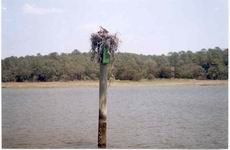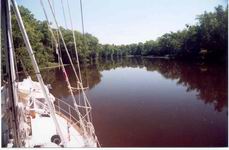Date: 24 May, 2001
Port of Call: Prince Creek, Waccamaw River, South Carolina
Subject: The Low Country
With all of our visiting completed and Sovereign's lockers crammed full of stores, we left Brunswick Landing Marina late in the morning of May 15th, and motored 15 miles to an anchorage on the Frederica River just in front of Fort Frederica. The nice short day was a good way to get used to being under way again without being too taxing. We took in the vista of the early 18th century fort set amid Georgia's tidal marshes and enjoyed the serenity of these coastal lowlands.
The next day as we motored up the Frederica River, we watched alligators sunning themselves on the muddy banks or peeking their eyes and snouts above the brown water. Sedate herons stalked through the shallows on stilt-like legs, while more lively sea birds plunged the deep waters of mid-river for their meals.
This area of coastal Georgia and South Carolina is sometimes called the "low country" because much of it is under water at high tide. We motor through mile after mile of winding rivers flanked with spartina grass. The yard-tall grass is as green as a lawn this time of year, but is capped with wheat-colored tops where the water only infrequently reaches. In the distance across the miles of marshes, clumps of live oaks or palmettos are visible on the barrier islands, while the mainland is lined with pines and, infrequently, a house or two.
In these back rivers we often see the curved backs and distinctive fins of dolphins surfacing, but they show little interest in us. The air is full of whirling and diving birds as well as unusually thick swarms of horse flies. Noticeably absent are the shrimp boats that normally trawl these waters for their catch. With the collapse of local shrimp populations and the closure of the fishery, we have these waters almost entirely to ourselves.
We quickly get into a routine of getting underway between 0800 and 0900, motoring about 40 miles, and anchoring in a side-creek off the main waterway by around 1600. In just a few days we pass behind the barrier islands of St. Simons, Sapelo, St. Catherines, Ossabaw, and Skidaway.
Osprey nest near Skidaway Island
 As we approach Savannah, Georgia, the solitude of the salt marshes quickly
gives way to the affluent suburbs of the Isle of Hope. Huge mansions
sprawl along the waterfront, and small private docks and large marinas line
the water's edge. Incongruously amid all the development, a large population
of ospreys has chosen this area as their home. Nearly every daymarker
on the waterway supports a jumble of sticks and branches that are the unmistakable
home of these predatory birds.
As we approach Savannah, Georgia, the solitude of the salt marshes quickly
gives way to the affluent suburbs of the Isle of Hope. Huge mansions
sprawl along the waterfront, and small private docks and large marinas line
the water's edge. Incongruously amid all the development, a large population
of ospreys has chosen this area as their home. Nearly every daymarker
on the waterway supports a jumble of sticks and branches that are the unmistakable
home of these predatory birds.We shoot across the Savannah River, which is less than 1/4 mile wide here, and we are immediately in the undeveloped marshland of South Carolina. As we proceed northward, the muddy brown banks capped by marsh grass gradually give way to creamy yellow shell banks. The hubbub of Hilton Head passes in our wake, and we spend a night anchored off the typical southern town of Beaufort (BYOO-fert), South Carolina.
We pass through Charleston, South Carolina on a Sunday, and it seems that every Charlestonian is out on the water in a powerboat or JetSki. We miss the opening of the Ben Sawyer Bridge by five minutes and have to wait another 55 bouncing in the wake and wash of a continuous stream of boat traffic. Once clear of Charleston, the waterway reverts to a less developed and less trafficked state.
By Monday night we are in Georgetown. We spend an extra day there to do laundry and stock up on a few fresh items. It is also time to change the engine oil and filters, and as I make my normal inspection, I notice some melted insulation on the wires connecting to the positive post of the high-output alternator. While trying to remove the nut that holds the wires on, I shear off the stud on the alternator, rendering it useless. Fortunately, the lower output backup alternator is still working. So for the time being we are on reduced power rations until we can get the main alternator repaired. At least we are in the U.S., where repair or replacement should be relatively simple.
Waccamaw River
 On Wednesday morning we fuelled up and left Georgetown, heading north up
the Intracoastal Waterway. Just north of Georgetown the waterway changes
from low salt marshes to abandoned rice fields to dense cypress swamp.
We enter the Waccamaw River, probably our favorite part of the waterway.
The Waccamaw is narrow, deep, and winding. Trees grow straight and
tall at the waters edge; we are motoring through a forest. We take
a "long-cut" at Prince Creek, bypassing the main route of the waterway for
this little byway. Here we are far removed from any evidence of human
development. The cypress forest is a lush jumble of shades of green.
At the edge of the creek, turtles sun themselves on logs and lilypads, and
wild Cherokee roses peek from beneath the dense forest canopy. We hear
the tapping of woodpeckers, the hoots of owls, and the songs of many birds
whose calls we recognize but can't name. Frogs and insects chirp in
the background, and none of this audible beauty is marred by the rumble of
an engine, the hum of an air conditioner, or the roar of traffic.
On Wednesday morning we fuelled up and left Georgetown, heading north up
the Intracoastal Waterway. Just north of Georgetown the waterway changes
from low salt marshes to abandoned rice fields to dense cypress swamp.
We enter the Waccamaw River, probably our favorite part of the waterway.
The Waccamaw is narrow, deep, and winding. Trees grow straight and
tall at the waters edge; we are motoring through a forest. We take
a "long-cut" at Prince Creek, bypassing the main route of the waterway for
this little byway. Here we are far removed from any evidence of human
development. The cypress forest is a lush jumble of shades of green.
At the edge of the creek, turtles sun themselves on logs and lilypads, and
wild Cherokee roses peek from beneath the dense forest canopy. We hear
the tapping of woodpeckers, the hoots of owls, and the songs of many birds
whose calls we recognize but can't name. Frogs and insects chirp in
the background, and none of this audible beauty is marred by the rumble of
an engine, the hum of an air conditioner, or the roar of traffic.Almost every day we have been comparing this cruise with our last year in the Caribbean. One would think that white sandy beaches and turquoise water would win hands down over the salt marshes and muddy rivers of the Low Country, but we haven't found that to be true for us. Waterway cruising is so much easier: we can go as many or as few miles as we want in a day; we can anchor every night in places more calm and secure than the best of the Caribbean's so-called "hurricane holes"; we can enjoy the solitude of a lonely anchorage or, if we are inclined, the bustle of a large city. The scenery, though vastly different, is every bit as beautiful as the Caribbean. We feel a little like Dorothy at the end of the Wizard of Oz, learning that she didn't need to travel any further than her own back yard. Maybe our back yard is a little bigger than most, but so far we have found that the East Coast of the U.S. is a mighty fine back yard to play in.
Smooth sailing,
Jim and Cathy